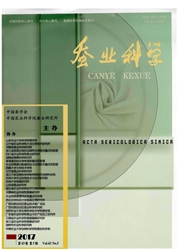

 中文摘要:
中文摘要:
家蚕肠道菌群与蚕体对营养物质的消化吸收及健康性密切相关。为了解家蚕肠道细菌的多样性及雌、雄个体间肠道细菌类群的差异,通过应用454焦磷酸测序技术检测细菌16S rRNA基因序列的方法分析家蚕5龄第3天雌、雄幼虫中肠内容物中的细菌类群,共发现5 578个分类操作单元(operational taxonomic units),包括14个门、21个纲、30个目、71个科、120个属的细菌,雌、雄个体在上述分类阶元共有的肠道细菌菌群分别为8、9、20、38和46种。在属水平上对细菌菌群构成的分析显示,雄蚕肠道中的主要优势细菌为代尔夫特菌属Delftia、橙单胞菌属Aurantimonas、肠球菌属Enterococcus、嗜糖假单胞菌属Pelomonas、青枯菌属Ralstonia、台湾温单胞菌属Tepidimonas、假单胞菌属Pseudomonas、阿斯普罗单胞菌属Aspromonas、甲基杆菌属Methylobacterium和葡萄球菌属Staphylococcus;雌蚕肠道中的主要优势细菌为代尔夫特菌属Delftia、橙单胞菌属Aurantimonas、假单胞菌属Pseudomonas、嗜糖假单胞菌属Pelomonas、佩特罗菌属Petrobacter、肠球菌属Enterococcus、台湾温单胞菌属Tepidimonas、狭义的梭菌属Clostridium sensu stricto、阿斯普罗单胞菌属Aspromonas。其中,雄蚕肠道中有23个属的细菌丰度是雌蚕的1.5倍以上,在雌蚕肠道中有7个属的细菌丰度是雄蚕的1.5倍以上,表明雌性与雄性家蚕肠道细菌类群的组成和比率存在明显差异。基于16S rRNA基因序列的聚类分析显示,家蚕肠道中的优势细菌属可分为2个大类。家蚕肠道细菌的多样性研究结果可作为探讨雌蚕和雄蚕经济性状差异的新线索。
 英文摘要:
英文摘要:
The intestinal bacteria are closely related to the digestion and absorption of nutrients,and the health of silkworm,Bombyx mori. To understand the intestinal bacterial diversity of silkworm and difference of intestinal colonies between the male and female silkworm,bacterial colonies in the intestinal contents of day 3 larvae of the fifth instar were investigated based on 16 S rRNA gene sequences which were obtained through 454 pyrosequencing technology. As a result,5 578 operational taxonomic units including 14 phyla,21 classes,30 orders,71 families and 120 genera were found,in which 8 phyla,9 classes,20 orders,38 families and 46 genera were shared by the male and female silkworm. The analysis of bacterial colony composition at genus level indicated that the predominant bacteria in the male silkworm were from genera of Delftia,Aurantimonas,Enterococcus,Pelomonas,Ralstonia,Tepidimonas,Pseudomonas,Aspromonas,Methylobacterium and Staphylococcus,and those in the female silkworm were from genera of Delftia,Aurantimonas, Pseudomonas, Pelomonas, Petrobacter,Enterococcus,Tepidimonas,Clostridium sensu stricto and Aspromonas. The abundance of 23 genera in the male silkworm was 1. 5 times as much as that in the female silkworm,while the abundance of 7 genera in the female silkworm was 1. 5times as much as that in the male silkworm,suggesting that there was obvious difference in the composition and proportion of intestinal bacteria between the male and female silkworm. Cluster analysis based on 16 S rRNA gene showed that the predominant intestinal bacteria in silkworm could be divided into two groups. These findings provide a new clue for exploring the difference of economic traits of the male and female silkworm.
 同期刊论文项目
同期刊论文项目
 同项目期刊论文
同项目期刊论文
 SHOTGUN PROTEOMIC ANALYSIS OF WING DISCS FROM THE DOMESTICATED SILKWORM (BOMBYX MORI) DURING METAMOR
SHOTGUN PROTEOMIC ANALYSIS OF WING DISCS FROM THE DOMESTICATED SILKWORM (BOMBYX MORI) DURING METAMOR Effect of inhibiting the expression of insulin-like peptide gene BBX-B8 on development and reproduct
Effect of inhibiting the expression of insulin-like peptide gene BBX-B8 on development and reproduct Alternative splicing, expression patterns and promoter characters of vasa-like gene from the silkwor
Alternative splicing, expression patterns and promoter characters of vasa-like gene from the silkwor Effects of BmKIT 3R gene transfer on pupal development of Bombyx mori Linnaeus using a Gal4/UAS bina
Effects of BmKIT 3R gene transfer on pupal development of Bombyx mori Linnaeus using a Gal4/UAS bina Characterization of the complete genome segments from BmCPV-SZ, a novel Bombyx mori cypovirus 1 isol
Characterization of the complete genome segments from BmCPV-SZ, a novel Bombyx mori cypovirus 1 isol Elementary research of the formation mechanism of sex-related fluorescent cocoon of silkworm, Bombyx
Elementary research of the formation mechanism of sex-related fluorescent cocoon of silkworm, Bombyx 期刊信息
期刊信息
